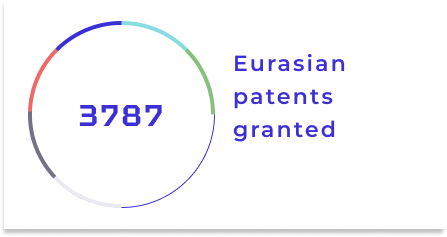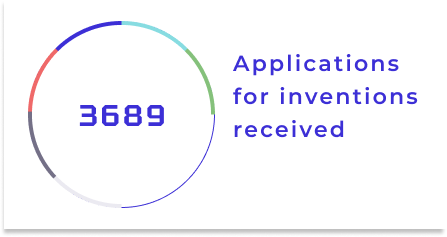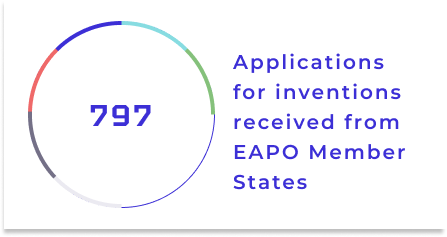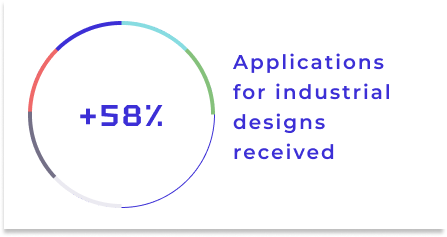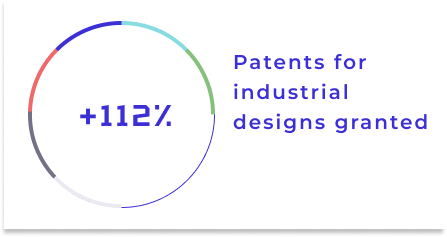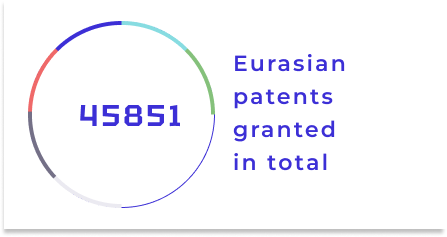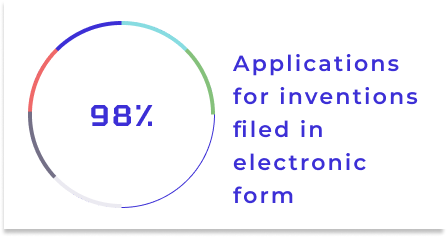Provision of High-Quality Products and Services by the Eurasian Patent Office
Key priority area of the Development Program of the Eurasian Patent Organization
Providing high-quality products and services is a key priority of the Eurasian Patent Organization's Development Program for 2023–2028, which was approved by the Administrative Council of the Eurasian Patent Organization on May 18, 2023.
The Quality Management System of the Eurasian Patent Office (EAPO) was established in 2011, and it is constantly being improved. Currently, the Quality Management System is based on the following regulatory documents:
- Quality Management Policy approved by the President of the EAPO
- Quality management system for patent search and examination
- Quality Council, whose activities are governed by the Regulations on the Quality Council
- Regulation on the Quality Monitoring Center
The EAPO strives to ensure that products and services provided to its users are of high quality.
The EAPO's Quality Management Policy provides for the following:
- Continuous development and improvement of the existing quality management system.
- Identification of risks and opportunities relevant to the quality of patent search, examination, and other services provided by the EAPO.
- Regular effectiveness monitoring of the existing Quality Management System in order to minimize possible negative consequences in the event of deviation from the planned results.
- Guidance of the Quality Management System by global best practices.
The following officials, bodies, and structural divisions ensure the functioning of the quality management system:
- President of the EAPO
- Quality Council of the EAPO
- Examination Department of the EAPO
- Quality Monitoring Center of the EAPO
The EAPO has a two-level quality control system for examination and patent search:
- internal control is provided by the Examination Department of the EAPO.
- external control is provided by the Quality Monitoring Center of the EAPO, which is an independent department directly subordinate to the President of the EAPO.
Internal control continuously in operational regimen monitors the key points of the examination process, namely, the timing of various actions, and the quality of preparation of the working products of examination - patent search reports, notifications sent to applicants during substantive examinations, and decisions taken based on the results of examination.
Internal control is provided by:
- automated systems for the administration of patent search and examination procedures, monitoring of the timing and the order of priority of the examination of applications, as well as the provision of flexible management of the applications portfolio:
- collegial decision taking on applications for inventions. The panel consists of three examiners who are experts in the given technical field:
- sample checks of examination working products carried out by the heads of the examination divisions:
- the supervisor system and the structure of the subordination of less qualified examiners to more qualified ones, including to the heads of the examination divisions.
External control is aimed at:
- the arrangement of scheduled and unscheduled auditing at any stage of examination and patent search, including international search and international preliminary examination, with the analysis of the results of checks and the development of proposals for corrective measures;
- the review of requests received from applicants or Eurasian patent attorneys with the identification of substantiated complaints on examination actions, the analysis of their causes, and the development of proposals for corrective measures;
- the analysis of feedback from users of the Eurasian patent system, the identification of problematic issues in the interaction between them and the EAPO, and the preparation of proposals to improve the system of interaction and the regulatory legal acts governing various aspects of the examination procedure.
The following measures are applied to eliminate the deficiencies identified and to improve the quality of the work performed:
- training of both the examiner who committed the deficiencies and with the rest of the examination staff, if necessary
- improvement of the regulatory legal acts governing the procedures and terms for such actions in the EAPO
- continuing education or professional retraining of examiners at the cost of the EAPO, master's and postgraduate studies
- internships and experience exchange in leading global patent offices.
The EAPO is developing measures to bring the Quality Management System in line with the requirements of international standards (ISO 9001-2015), a working group was established in 2023 for preparations to the certification of the EAPO’s quality management system for compliance with the requirements of the Standard ISO 9001-2015, and the scope of certification were defined covering the procedures for patenting inventions - patent search and substantive examination. In 2023, the EAPO began to operate an online system for monitoring the user satisfaction through questionnaires and the analysis of the information received. The user feedback system is located on the EAPO web portal, and questionnaires are also posted in the personal accounts of registered users of the EAPO-ONLINE system.
The use of up-to-date IT technologies in the EAPO at all stages of workflow of applications has a great impact on the quality of services provided. Thus, in 2023, about 98 per cent of Eurasian applications for inventions were filed in electronic form, which speeds up the processing of applications at all stages of examination, ensures the complete preservation of information and the automated calculation of the correctness of the amounts of the patent fees paid and their payment terms.
The EAPO's automated workflow systems and search systems help examiners to perform their main function, good quality examination of applications for invention, since they ensure the completeness of patent search and monitor the timing of the processes established. The EAPO also has access to specialized paid databases that allow carrying out international-type patent searches for all Eurasian applications.
On October 7, 2021, at the sixty-second session of the meetings of the Assemblies of Member States of the World Intellectual Property Organization (WIPO), the EAPO was appointed as an International Searching Authority and International Preliminary Examining Authority under the Patent Cooperation Treaty (PCT). The Eurasian Patent Office began its functioning as an International Authority under the PCT on July 1, 2022.
Thus, applicants may pass through all stages of the examination of international applications in the EAPO, beginning from the filing of applications with the Receiving Office, the conduct of international patent search, the conduct of international preliminary examination, and entering to the regional phase of examination of applications in the EAPO as a Designated/Elected Office.
WIPO imposes high requirements on International Searching Authorities. In particular, the PCT International Search and Preliminary Examination Guidelines include Chapter 21, which explicitly provides for International Searching Authorities to have Quality Management Systems.
At the same time, it is necessary to constantly monitor the quality management system and submit annual reports on changes that have occurred to WIPO. Such a report was submitted in 2023.
In accordance with the quality action plan, the Quality Monitoring Center carried out 12 scheduled and unscheduled audits in 2023 as part of external quality control. The audits concerned the quality of patent search conducted by examiners from the EAPO’s Examination Department and of the work products prepared by examiners within the examination of Eurasian applications.
Thus, in 2023, the following activities were conducted:
- the verification of primary decisions on granting Eurasian patents; 365 Eurasian applications were selected for verification;
- the check of 166 patent search reports prepared by the EAPO on Eurasian applications, and all international search reports and international preliminary examination reports prepared by the EAPO as International Authority under the PCT system;
- the check of 250 long-term applications containing 5 or more notifications;
- the unscheduled verification of particular examiners on 80 applications;
a statement was drawn up for each audit with an analysis of the deficiencies committed and the corrective measures.
The Quality Monitoring Center examined requests from natural and legal persons throughout the year. In 2023, the EAPO received 10 requests concerning the correctness of the methodological approaches applied in various situations of substantive examination, the correctness of the payment of patent fees and the calculation them taking into account the benefits provided, the specifics of filing of appeals, and more. In one case, the request was recognized as a substantiated complaint regarding the legality of the recognition of the patentability of the invention, however, it should be noted that the decision to grant the patent was made back in 2005. Since then, the EAPO has established an effective quality management system aimed at improving the quality of patent search and the effectiveness of examination.
The EAPO’s Quality Monitoring Center took part in the World Quality Day – 2023 international forum, which was held on November 7–10, 2023 in Moscow.
Eurasian Patent Examination
The Eurasian Patent Office received 3,689 Eurasian applications for inventions and 369 Eurasian applications for industrial designs in 2023.
Statistics of Eurasian Applications for Inventions
In 2023, the number of Eurasian applications for inventions received remained at the level of 2022. The number of Eurasian patent applications received by the Eurasian Patent Office decreased by about 1 per cent compared to the number of Eurasian applications received in 2022.
A total of 71,794 Eurasian patent applications were filed from 1996 to 2023, inclusive.
Diagram 1 presents detailed numbers on the Eurasian patent applications filed in the last 20 years.
Diagram 1.
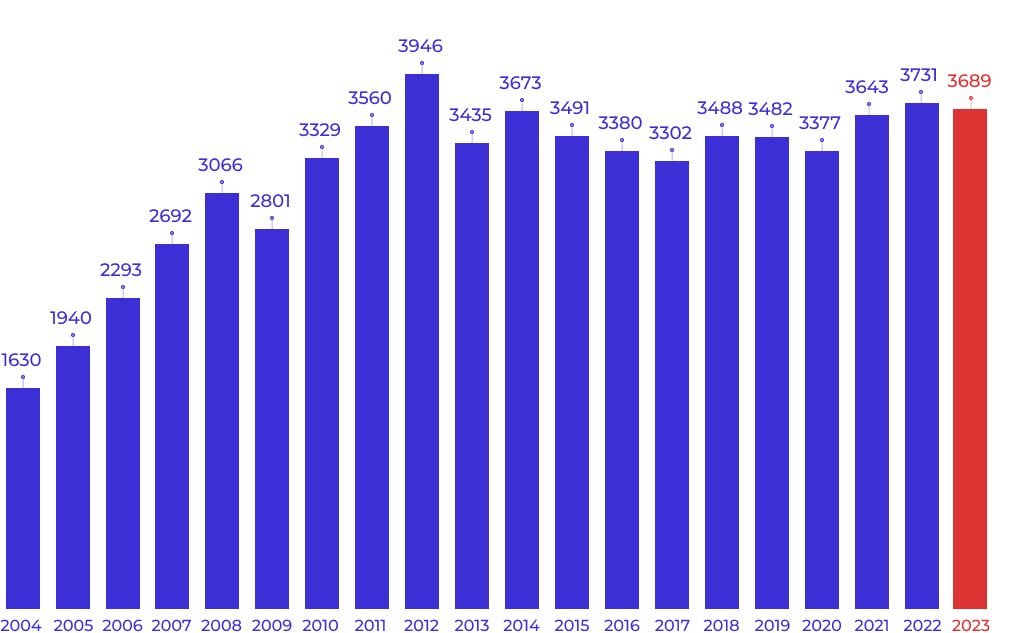
Diagram 2 presents the distribution of Eurasian patent applications by the specifics of their filing procedure.
Diagram 2.
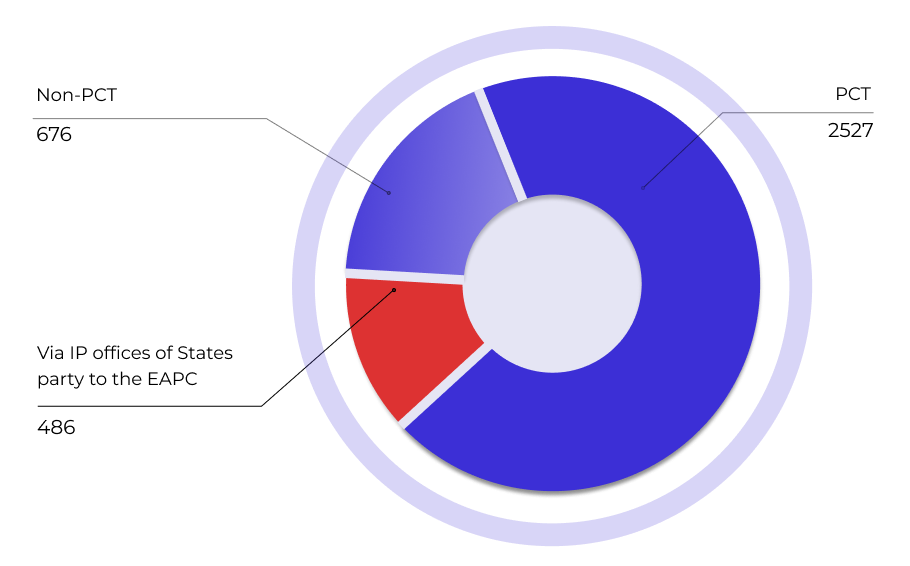
International applications accounted for the bulk of patent applications in 2023, totaling 2,527 Eurasian applications, or 69 per cent of all Eurasian applications filed.
The year 2023 saw 676 Eurasian applications filed directly with the Eurasian Patent Office, or 18 per cent of all Eurasian applications filed in the period under review. Notably, 486 Eurasian applications were filed in 2023 via the national IP offices of Contracting States to the Eurasian Patent Convention (EAPC), or 13 per cent of all Eurasian applications filed.
Diagram 3 shows the distribution of Eurasian applications from the countries which had the largest numbers of Eurasian applications in 2023. In total, in 2023, applications were filed by applicants from 66 countries (from 133 countries over the whole history).
Diagram 3.
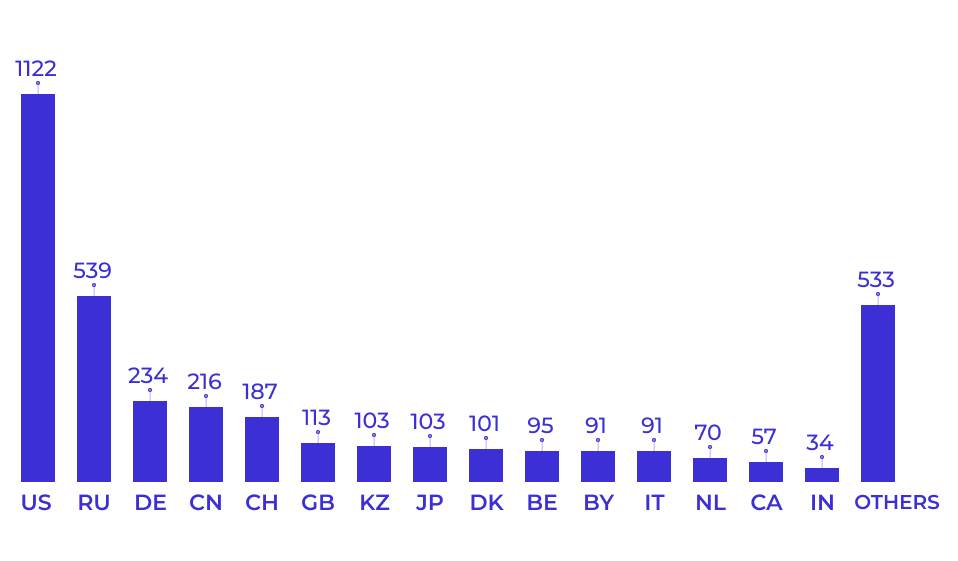
As in the preceding years, the United States of America proved to be the largest geographical source of applications, representing 1,122, or 30.4 per cent of all applications filed with the Eurasian Patent Office.
In 2023, applicants from the Contracting States to the EAPC filed 797 Eurasian applications.
The largest number of Eurasian patent applications was from the Russian Federation, with 539 applications, the Republic of Kazakhstan, with 103 applications, the Republic of Belarus, with 91 applications, and the Republic of Azerbaijan, with 34 applications.
Diagram 4 shows the trend in Eurasian patent application filing under the aforementioned procedures for applicants from Contracting States to the EAPC.
Diagram 4.
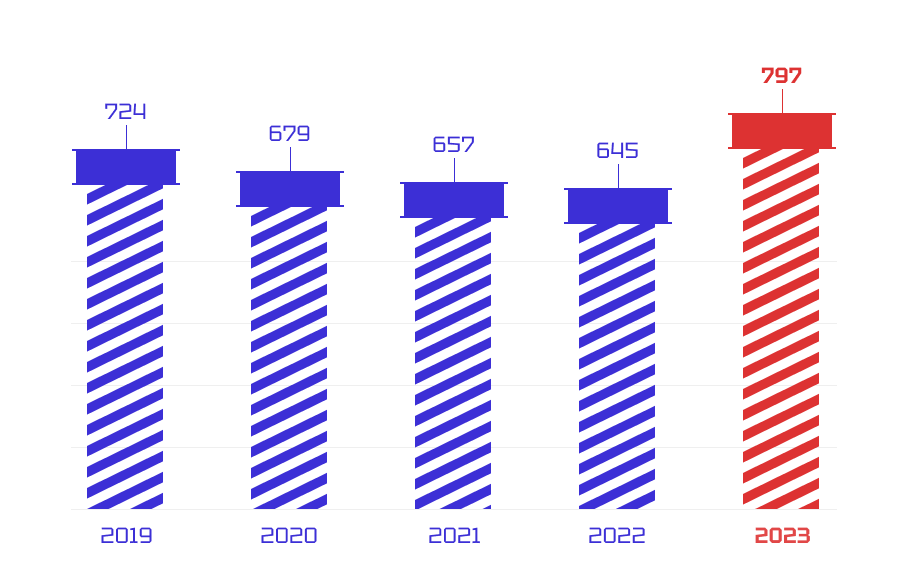
In 2023, the most applications were filed for inventions in organic chemistry, pharmaceuticals, and medicines. Table 1 shows the distribution of Eurasian applications filed in 2023 by subject matter.
The year 2023 saw 3,609 Eurasian applications filed electronically, which is 98 per cent of all Eurasian applications received in 2023.
Table 1. Eurasian applications filed in 2023 by technical field
|
Total |
|
|
Combinatorial Technology (C40) |
0.03 per cent |
|
Biochemistry, sugar industry, leathers (C12–C14) |
5.46 per cent |
|
Paper-making (D21, B31) |
0.07 per cent |
|
Hydraulic and pneumatic mechanisms (F15–F17) |
0.71 per cent |
|
Mining (E21) |
1.54 per cent |
|
Engines and pumps (F01–F04) |
1.13 per cent |
|
Measurements and optics (G01–G03) |
3.59 per cent |
|
Information technologies (G16) |
0.18 per cent |
|
Paints and dyes, fuel, animal and vegetable oil (C09–C11) |
1.22 per cent |
|
Medications and pharmaceuticals (A61K) |
23.09 per cent |
|
Medicine and veterinary (A61–A63 except for A61K) |
8.06 per cent |
|
Metallurgy and electrolysis (C21–C23, C25) |
1.54 per cent |
|
Nanotechnology (B82) |
0.03 per cent |
|
Inorganic chemistry (C01–C05, C30) |
2.40 per cent |
|
Working and shaping (B21–B30, B32) |
1.36 per cent |
|
Wearing apparel, personal and domestic articles (A41–A47) |
0.68 per cent |
|
Organic chemistry (C07, A01N) |
26.41 per cent |
|
Organic macromolecular compounds (C08) |
0.56 per cent |
|
Weapons and ammunition (F41, F42, C06) |
0.36 per cent |
|
Lighting, heating, and refrigeration (F21–F28) |
1.33 per cent |
|
Printing and decorative arts (B41–B44) |
0.21 per cent |
|
Foodstuffs and tobacco (A21–A24) |
3.05 per cent |
|
Agriculture (A01 except for A01N) |
2.52 per cent |
|
Educational appliances (G09–G12) |
0.33 per cent |
|
Building (E01–E06) |
2.40 per cent |
|
Textiles (D01–D07) |
0.36 per cent |
|
Horology, computing, signaling (G04–G08) |
2.02 per cent |
|
Transporting (B60–B68) |
3.17 per cent |
|
Physical and chemical processes (B01–B09) |
3.21 per cent |
|
Electricity (H01, H02, H05) |
1.69 per cent |
|
Electronic circuitry and electronic communication (H03, H04) |
0.65 per cent |
|
Nuclear physics (G21) |
0.65 per cent |
|
Total |
100.00 per cent |
The average duration of first action of examination in 2023
|
Value (months) |
|
|
Chemistry and Medicines Division |
12.40 |
|
Examination Department (as a whole) |
8.91 |
|
Mechanics, Physics, and Electrical Engineering Division |
2.64 |
The average duration of application examinations as of the end of 2023
|
On the examination side (months) |
On the applicant’s side (months) |
Total (months) |
|
|
Chemistry and Medicines Division |
3.56 |
9.96 |
13.52 |
|
Examination Department (as a whole) |
3.19 |
8.39 |
11.58 |
|
Mechanics, Physics and Electrical Engineering Division |
2.66 |
5.99 |
8.65 |
Eurasian Industrial Design Application Statistics
The Eurasian Patent Office received 369 Eurasian industrial design applications in 2023. In this, these Eurasian applications declared a total of 860 industrial designs.
Applicants from the EAPC Contracting States filed 299 Eurasian applications for 610 industrial designs in 2023. Among them, applicants from the Russian Federation filed 256 applications for 521 industrial designs, applicants from the Republic of Belarus filed 27 applications for 68 industrial designs, applicants from the Republic of Kazakhstan filed 15 applications for 20 industrial designs, and applicants from the Republic of Armenia filed 1 application for 1 industrial design.
Applicants from States not party to the EAPC filed 70 Eurasian applications for 250 industrial designs in 2023. Among them, applicants from China filed 21 applications for 57 industrial designs, applicants from the United States of America filed 14 applications for 86 industrial designs, applicants from the United Kingdom filed 10 applications for 26 industrial designs, applicants from Saint Kitts and Nevis filed 6 applications for 6 industrial designs, applicants from Belgium filed 3 applications for 12 industrial designs, applicants from Japan filed 2 applications for 15 industrial designs, applicants from Canada filed 2 applications for 14 industrial designs, applicants from Denmark filed 2 applications for 5 industrial designs, applicants from France filed 2 applications for 3 industrial designs, applicants from Bulgaria filed 2 applications for 3 industrial designs, applicants from Netherlands filed 1 application for 9 industrial designs, applicants from Italy filed 1 application for 6 industrial designs, applicants from Turkey filed 1 application for 4 industrial designs, applicants from Georgia filed 1 application for 2 industrial designs, applicants from Singapore filed 1 application for 1 industrial design, and applicants from the Republic of Korea filed 1 application for 1 industrial design.
Diagram 5 shows the distribution of Eurasian industrial design applications received in 2023 and the number of industrial designs included in them, respectively, by country of origin. Applications were received from applicants from 20 countries in 2023. Applications have been filed by applicants from 26 countries over the entire period the Eurasian system for the legal protection of industrial designs has functioned. In 2023, Eurasian industrial design applications were received for the first time from applicants from St. Kitts and Nevis, Singapore, France, the Netherlands, Denmark, Korea, Belgium, Georgia and Armenia.
Diagram 5.
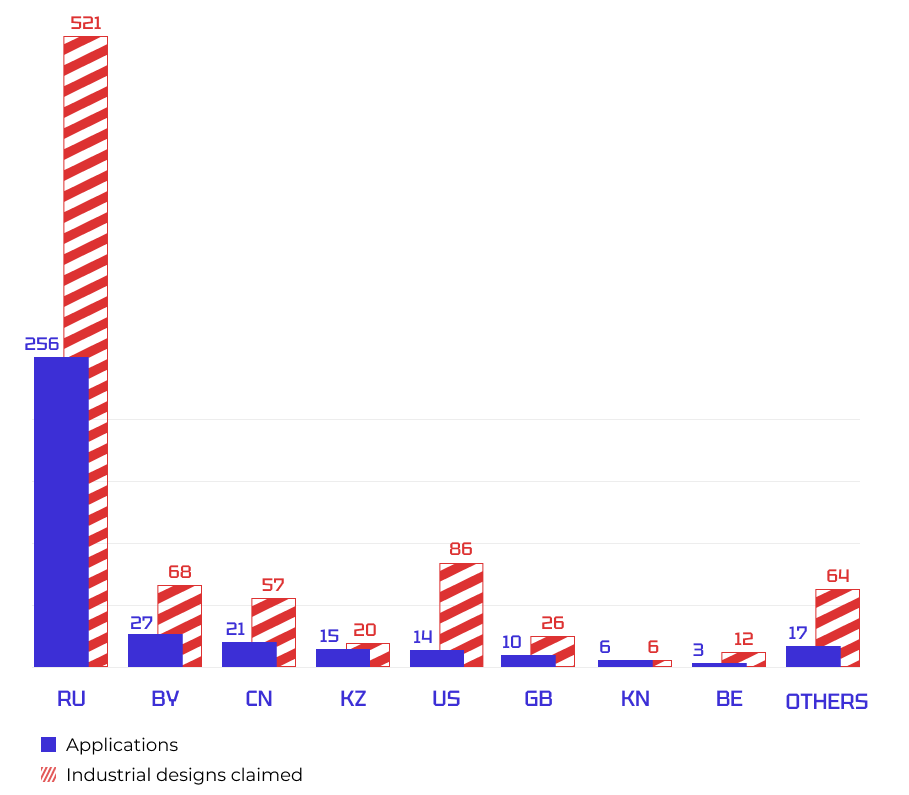
The list of products for which Eurasian applications for industrial designs were filed expanded to 28 classes of the International Classification for Industrial Designs (ICID) in 2023.
The largest numbers of industrial design applications were filed in the following ICID classes:
Class 9 (Packaging, boxing, and containers for the transport or storage of goods)
Class 12 (Means of transport and hoisting)
Class 6 (Furniture items)
Class 25 (Building units and construction elements)
Class 11 (Articles of adornment)
Tables 1 and 2 show the distribution of Eurasian industrial design applications received in 2023 and the number of industrial designs included in them, respectively, by ICID class.
Table 1. Eurasian industrial design applications filed in 2023 by ICID class
Class |
Number |
09 Packaging and containers |
71 |
12 Means of transport and hoisting |
61 |
06 Furnishing |
47 |
25 Building units and construction elements |
21 |
11 Articles of adornment |
16 |
14 Recording, telecommunications, or data processing equipment |
12 |
21 Games, toys, tents and sports goods |
12 |
24 Medical and laboratory equipment |
11 |
08 Tools and hardware |
10 |
15 Machines, not elsewhere specified |
10 |
23 Fluid distribution equipment, sanitary, heating, ventilation and air-conditioning equipment |
10 |
32 Graphic symbols and logos, surfaces patterns, ornamentation, arrangement of interiors and exteriors |
10 |
19 Stationery and office equipment |
9 |
28 Pharmaceutical and cosmetic products, toilet articles and apparatus |
9 |
Other |
60 |
Table 2. Industrial designs included in Eurasian applications in 2023 by ICID class
Class |
Number |
09 Packaging and containers |
143 |
12 Means of transport and hoisting |
97 |
06 Furnishing |
80 |
11 Articles of adornment |
70 |
23 Fluid distribution equipment, sanitary, heating, ventilation and air-conditioning equipment |
66 |
25 Building units and construction elements |
55 |
32 Graphic symbols and logos, surfaces patterns, ornamentations, arrangement of interiors and exteriors |
55 |
08 Tools and hardware |
46 |
14 Recording, telecommunications, or data processing equipment |
44 |
21 Games, toys, tents and sports goods |
29 |
24 Medical and laboratory equipment |
25 |
28 Pharmaceutical and cosmetic products, toilet articles and apparatus |
25 |
07 Household goods |
21 |
19 Stationery and office equipment |
17 |
Other |
87 |
Eurasian patents
Eurasian patents for inventions
A record number of 3,787 Eurasian patents for inventions were granted in 2023. That is 37 per cent growth compared to the number of patents granted in 2022. In total, 45,851 Eurasian patents have been granted over the period of operation of the Eurasian Patent Office.
Diagram 1 presents detailed numbers on Eurasian patents granted over the past 20 years.
Diagram 1.
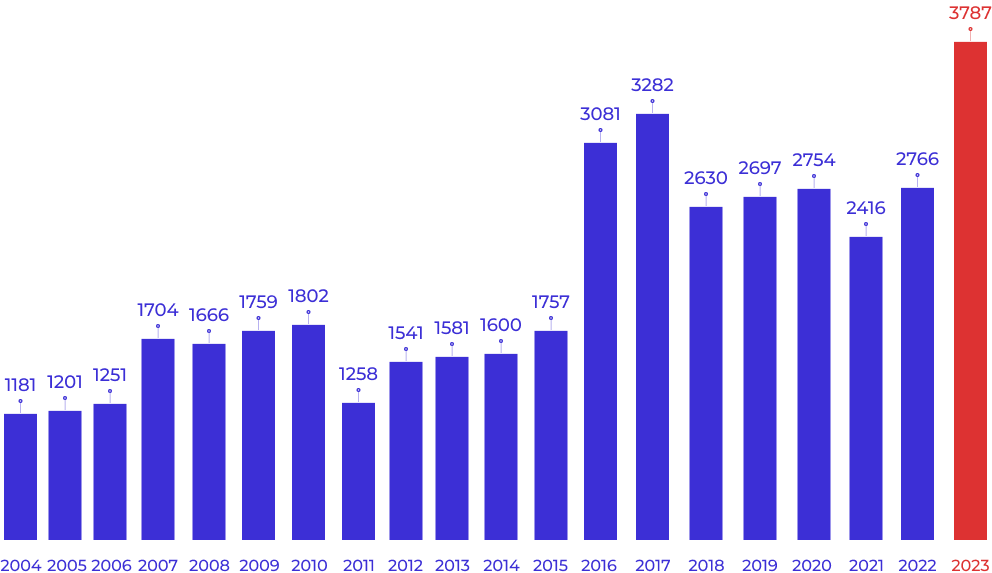
In 2023, representatives of 69 countries became Eurasian patent owners, including residents of 7 EAPC Contracting States.
Diagram 2 presents the distribution of Eurasian patents granted in 2023 by country of origin, for the countries whose applicants received the largest numbers of Eurasian patents.
Diagram 2.
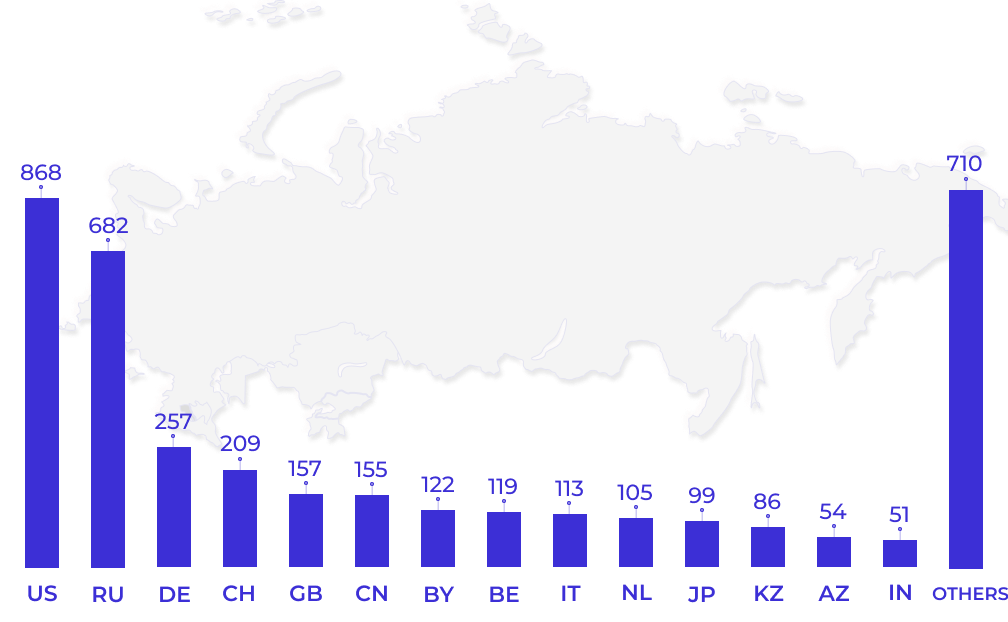
The main share of Eurasian patents granted in 2023, as in prior years, constituted international applications entered the regional phase at the Eurasian Patent Office under the PCT procedure: 2783 patents, or 73.5 per cent of the total number of patents granted.
Diagram 3.
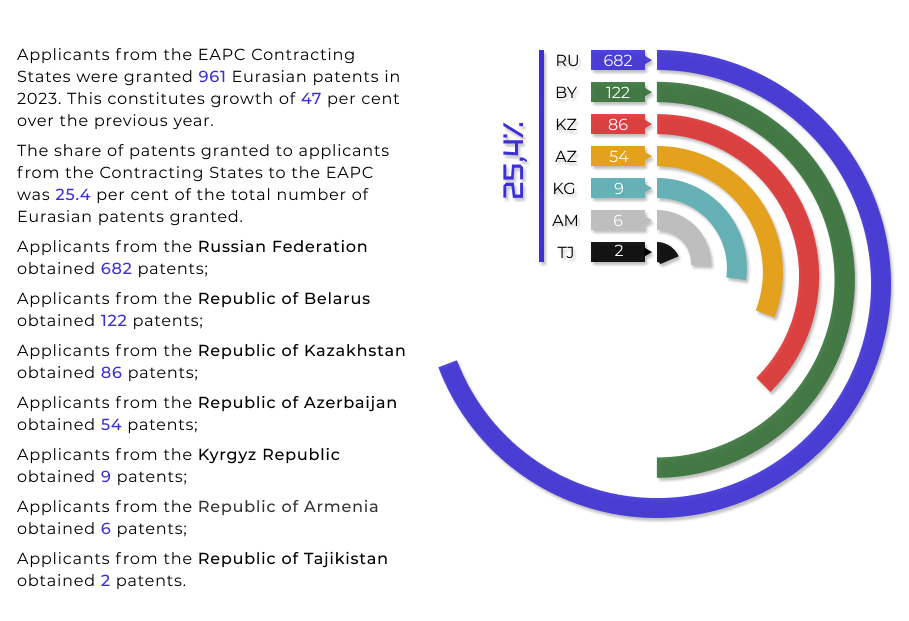
Applicants from States not party to the EAPC were granted 2,826 Eurasian patents in 2023. Their share amounted to 74.6 per cent of the total number of patents granted.
In 2023, the largest share of Eurasian patents was granted to applicants from the United States of America, with 868 patents, or 22.9 per cent of all patents granted.
As of the end of the reporting year, there were 19,828 Eurasian patents in force in the territory of the EAPC Contracting States and the Republic of Moldova. This indicator increased by 1,357 patents, or 7.3 per cent, compared to the previous year (18,471 patents).
Diagram 4. Validity of Eurasian patents in the EAPC Contracting States and the Republic of Moldova as of December 31 of the reporting year
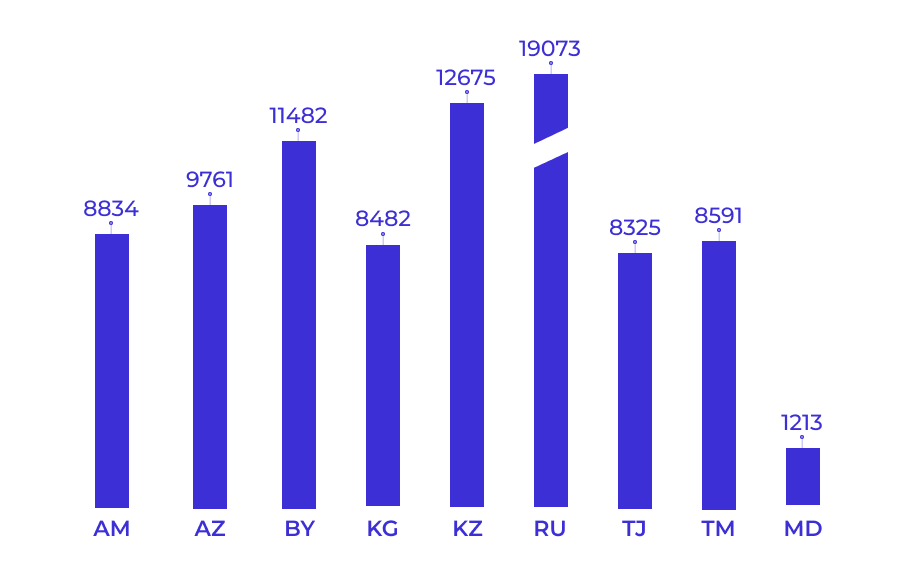
Eurasian Industrial Design Patents
In 2023, the number of Eurasian patents granted increased by 111.5 per cent compared to the previous year and amounted to 313 Eurasian patents. The patents protect 681 industrial designs.
In total, 468 patents for 1,115 industrial designs were granted in 2021–2023.
Diagram 1. Dynamics of Granting of Eurasian Industrial Design Patents
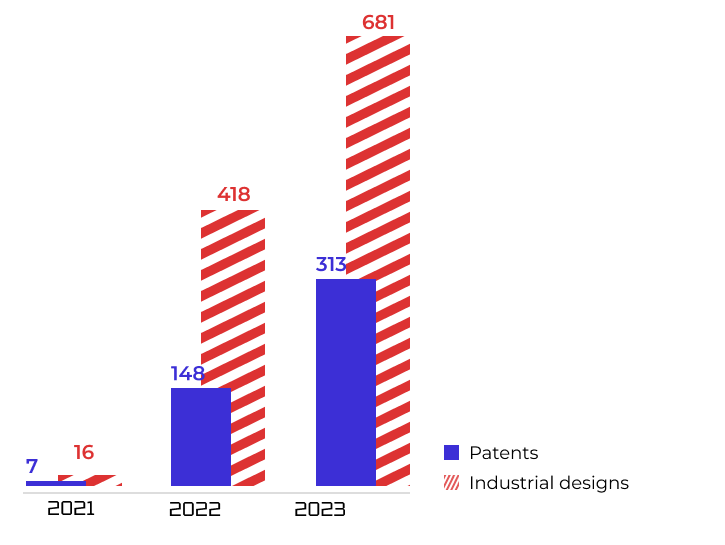
The geographic scope of Eurasian industrial design patents has expanded.
Whereas in 2022, patents were granted to applicants from 10 states, in 2023, representatives of 23 states, including 5 States party to the Protocol, became Eurasian patent holders.
The number of patents granted to applicants from the States party to the Protocol has increased 2.5 times.
A total of 264 Eurasian patents for industrial designs were granted to applicants from the States party to the Protocol, amounting to 84.3 per cent of the total number of patents granted in 2023 (105 patents were granted in 2022).
Among them, applicants from the Russian Federation received 239 patents for 429 industrial designs, applicants from the Republic of Belarus received 18 patents for 39 industrial designs, applicants from the Republic of Kazakhstan received 5 patents for 8 industrial designs, applicants from the Republic of Azerbaijan received 1 patent for 1 industrial design, and applicants from the Republic of Armenia received 1 patent for 1 industrial design.
The total number of Eurasian patents for industrial designs granted to applicants from States not party to the Protocol is 49, of 15.7 per cent of the total number of patents granted in 2023.
Among them, applicants from the United States of America received 17 patents for 104 industrial designs, applicants from the United Kingdom received 6 patents for 6 industrial designs, applicants from China received 3 patents for 4 industrial designs, applicants from Germany received 3 patents for 9 industrial designs, applicants from Canada received 2 patents for 13 industrial designs, applicants from Switzerland received 2 patents for 21 industrial designs, applicants from Denmark received 2 patents for 5 industrial designs, applicants from France received 2 patents for 3 industrial designs, applicants from Saint Kitts and Nevis received 2 patents for 2 industrial designs, applicants from Turkey received 2 patents for 5 industrial designs, applicants from Belgium received 1 patent for 5 industrial designs, applicants from Bulgaria received 1 patent for 3 industrial designs, applicants from Georgia received 1 patent for 2 industrial designs, applicants from China and the Hong Kong SAR received 1 patent for 1 industrial design, applicants from Italy received 1 patent for 3 industrial designs, applicants from Japan received 1 patent for 12 industrial designs, applicants from Poland received 1 patent for 4 industrial designs, and applicants from Singapore received 1 patent for 1 industrial design.
Diagram 2. Distribution of Eurasian industrial design patents granted in 2023 by state
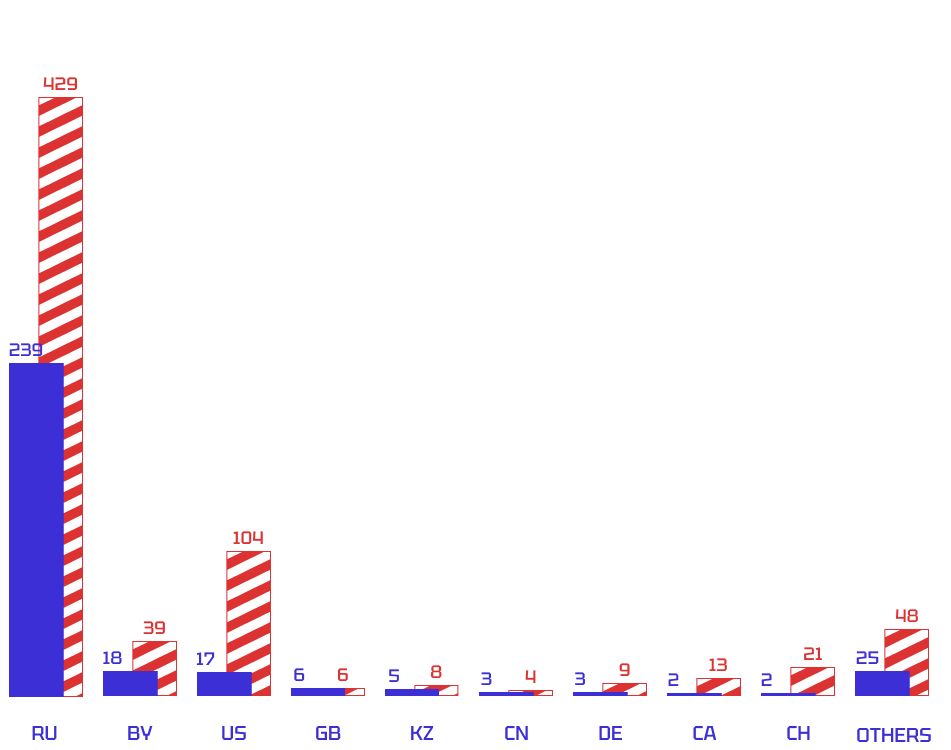
Table 1. Validity of Eurasian industrial design patents on the territory of States party to the Protocol as of December 31 of the reporting year
State party to the Protocol |
Number of valid Eurasian patents |
Republic of Armenia |
463 |
Republic of Azerbaijan |
463 |
Kyrgyz Republic |
463 |
Republic of Kazakhstan |
463 |
Russian Federation |
462 |
Republic of Tajikistan |
419 |
Republic of Belarus |
399 |
Patent Prosecution Highway (PPH) Programs
The patent offices of Japan, China, the Republic of Korea, as well as the European Patent Office (EPO), are partner offices of the Eurasian Patent Office for Patent Prosecution Highway (PPH) programs.
In 2023, the Eurasian Patent Office and the China National Intellectual Property Administration (CNIPA) signed a memorandum on the extension of the PPH program on an indefinite basis. Taking into account the appointment of the Eurasian Patent Office as an International Searching Authority (ISA) and International Preliminary Examining Authority (IPEA) under the Patent Cooperation Treaty (PCT), the PPH program was expanded to include the PCT working products prepared by the Eurasian Patent Office and the CNIPA under the PCT.
In total, in 2023, the Eurasian Patent Office received 20 requests for accelerated prosecution under PPH programs.
Activities of the Eurasian Patent Office as an International Searching Authority (ISA) and International Preliminary Examining Authority (IPEA) under the PCT
As an International Searching Authority, the Eurasian Patent Office prepared 23 international search reports together with the written opinions of ISA in 2023. The largest number of international searches was conducted on international applications filed by applicants from the Russian Federation: 18 applications. The remaining international searches were conducted on PCT applications filed by applicants from the Republic of Belarus (2 applications), the Republic of Azerbaijan (2 applications), and the Republic of Armenia (1 application).
As an International Preliminary Examining Authority, the Eurasian Patent Office prepared 3 reports on the international preliminary examination on PCT applications filed by applicants from the Russian Federation (2 applications) and by applicants from the Republic of Kazakhstan (1 application).
Certification and Registration of Eurasian Patent Attorneys
The Eurasian Patent Office conducted 31 qualification exams of candidate Eurasian patent attorneys in 2023. Based on their results, 17 candidates specializing in inventions and 13 candidates specializing in industrial designs were certified.
In 2023, 16 Eurasian patent attorneys specializing in inventions were registered, including 12 citizens of the Russian Federation, 3 citizens of the Republic of Kazakhstan, and 1 citizen of the Republic of Belarus, and 13 Eurasian patent attorneys specializing in industrial designs were certified, including 10 citizens of the Russian Federation, 2 citizens of the Republic of Kazakhstan, and 1 citizen of the Republic of Belarus.
There were 2 Eurasian patent attorneys excluded from the Register of Eurasian Patent Attorneys specializing in inventions.
There were a total of 570 registered Eurasian patent attorneys specializing in inventions and a total of 105 attorneys specializing in industrial designs in 2023. At the same time, 73 registered Eurasian patent attorneys specialize in both inventions and industrial designs.
Financial Performance
In the management of its finances during the reporting period, the Eurasian Patent Organization (EAPO) was guided by the Eurasian Patent Convention (EAPC), the Financial Regulations under the EAPC, and the effective laws of the country of location of the EAPO headquarters. The EAPO managed its finances in accordance with the budget for 2023 approved by the EAPO Administrative Council.
The amended EAPO budget for 2023 was adopted in accordance with Rule 9 of the Financial Regulations under the Eurasian Patent Convention at the forty-third (thirteenth extraordinary) meeting of the EAPO Administrative Council. Under conditions of continuing uncertainty and insufficient predictability of the macroeconomic dynamics, expressed, in particular, in the significant exchange rate volatility, the need to make changes to the budget was associated with significant adjustments of some items of both the revenue and expenditure chapters, which significantly affected the indicators of the budget adopted. Moreover, the practice of the simultaneous submission of changes to the current year's budget in combination with next year's draft contributes to the improvement of the effectiveness of medium-term planning and enables an increase in the reliability of long-term planning factors, which is especially relevant for the Eurasian Patent Organization after the adoption of the EAPO Development Program for 2023-2028.
The complex global geopolitical situation and negative trends in the global economy certainly affect the level of inventive and applicant activity, which is crucially important for the Eurasian Patent Organization, as its expenses are primarily covered by incoming fees. As the practice of the reporting year has shown, interest in the Eurasian regional patenting procedure remains stable. High applicant activity, combined with a positive trend in other volume indicators affecting financial results, contributed to the steady flow of revenue from fees and tariffs for Eurasian applications and patents in the reporting year.
It is important to note that the restrictions imposed in relation to the global payment system have still had no great effect on the Eurasian Patent Organization. As of this time, there have been no changes in the payment procedure in the context of the EAPO’s activities as an international organization.
The Diagram 1 shows the structure of Eurasian Patent Office revenue from fees and tariffs in 2023.
Diagram 1.
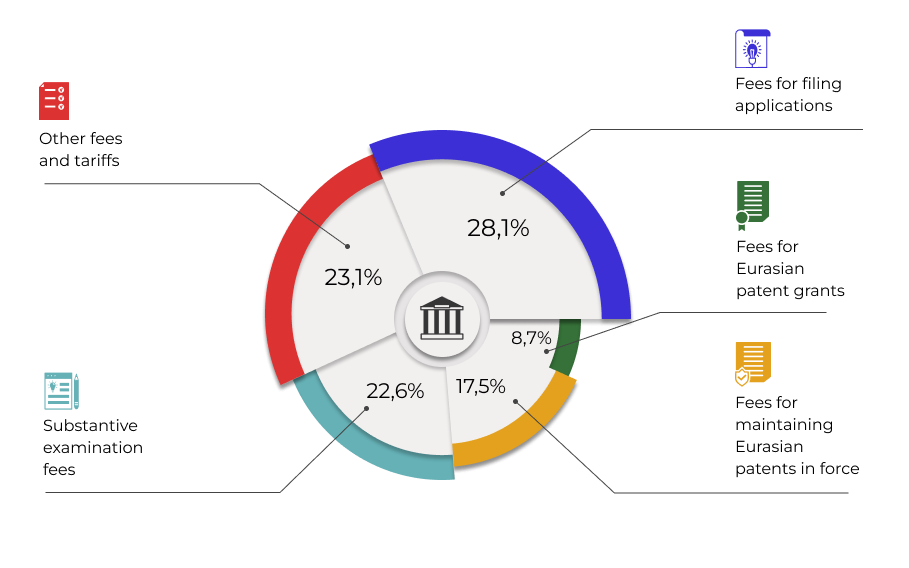
Revenue from fees for maintaining Eurasian patents in the territories of the EAPC Contracting States grew impressively in 2023.
The Diagram 2 shows the share of each State in the fees for the maintenance of Eurasian patents in the aggregate earnings for 2023.
Diagram 2.
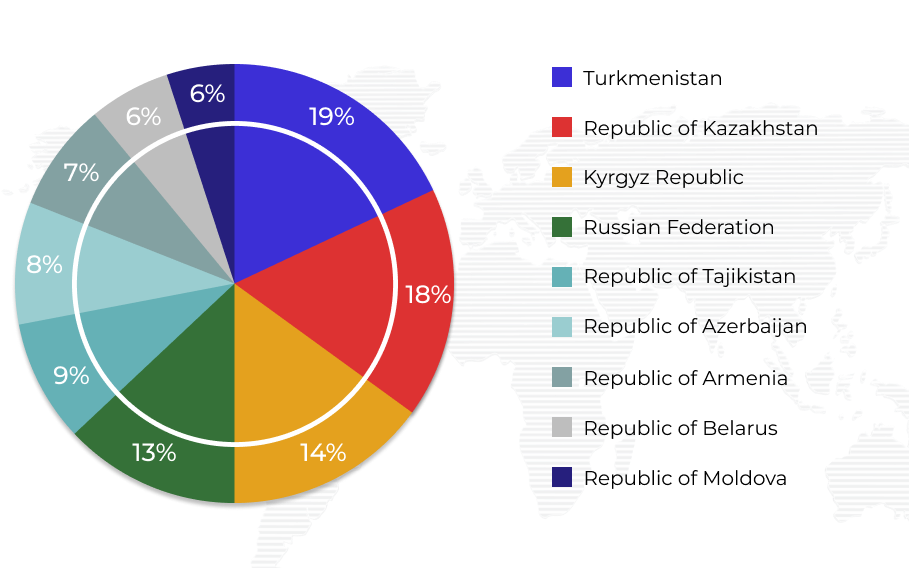
By the end of 2023, the size of the EAPO Reserve Fund was increased following the Procedure for Creating and Disbursing it. The Reserve Fund is intended to sustain the functionality of the Organization should it experience an unforeseen budget deficit.
By meeting its revenue target for the reporting year, the organization was able to fully finance its expenditures as budgeted and support the sustainability of its operations.
Educational Projects of the Eurasian Patent Office
The priority areas of the EAPO include public awareness and education, the raising the professional skills of the experts from Member States national IP offices and the Eurasian Patent Office, and the promotion of intellectual property among young people.
The Eurasian Patent Office successfully implemented a number of different educational projects in 2023.
The Eurasian Patent Office conducted 4 cycles of internships, in which 25 examiners and experts of national IP offices took part.
From June 19 to June 30, 2023, the Eurasian Patent Office hosted an internship for national patent office examiners on the Eurasian System for Patenting Inventions (specific features of the examination of Eurasian applications in the field of mechanics, physics, and electrical engineering). Practical Issues of Examination of Patent Applications. Experienced examiners of the Examination Department, experts of the Information Technology Department, as well as researchers and heads of the Physics and Applied Mechanics Center of the Federal Institute of Industrial Property helped participants complete the extensive internship program, which included theoretical and practical classes.
From July 3 to July 7, 2023, an internship was held for the first time for experts from the national IP offices under the program Distribution of Intellectual Property: New Approaches to the Management of IA in the Summer IP Academy in Sochi, a joint project of the Eurasian Patent Office and RSAIP. The project drew great interest and was highly appreciated by its participants.
The Eurasian Patent Office arranged two additional internship cycles in 2023 at the request of national patent offices. From September 25 to October 4, 2023, experts of the Information Security Division of the Eurasian Patent Office conducted the first cycle of practical training Creating a Secure and Continuous Infrastructure Platform for Unified EAPO IT Services; Building Information Security Management Systems. From December 18 to December 22, 2023, examiners from the Republic of Tajikistan completed an internship at the Examination Department of the Eurasian Patent Office on the Practical Issues of the Substantive Examination of Inventions Related to Computer and Information Technologies.
From December 4 to December 8, 2023, 6 IT experts from national patent offices were trained in the dedicated Softline training center in the Fundamentals of Python Programming.
In 2023, the Eurasian Patent Office continued to finance training at the Russian State Academy of Intellectual Property and the Scientific Educational Center of the Federal Institute of Industrial Property for representatives of national patent offices on relevant and in-demand programs of higher and additional professional education, as well as advanced training. There were 13 graduates of master's and bachelor's degrees, and 10 people completed postgraduate studies. The "Intellectual property. Patenting" professional retraining program was successfully mastered by 12 experts, and 22 people completed various advanced professional training programs.
The Eurasian Patent Office has implemented a fellowship program, a new educational project to train highly qualified examiners in the patent search and examination. The focus of the fellowship program in 2023 was the examination of inventions in the field of chemistry and medicine. During the year, 8 fellowship examiners with specialties of higher professional education corresponding to the program discipline and employed by the Examination Department of the Office, mastered a specially developed integrated program, including theoretical and practical classes at the EAPO headquarters, as well as a program of basic and advanced training of examiners at the FIPS Scientific Educational Center.
Advancing the Future Universiade
The annual Advancing the Future Eurasian Patent Universiade, the main purpose of which is to promote intellectual property among young people and to support talented young inventors and researchers, was held in 2023 with the support of the national patent offices of the EAPC Contracting States and with the active participation of the Russian State Academy of Intellectual Property.
More than 70 young inventors and authors of designer projects from 7 EAPC Contracting States took part in the Universiade.
There were 42 creative projects presented to the qualified jury in the 10–17 age category and 20 projects in the 18–25 age category. The main theme of all Universiade categories was the creation of new technologies and the improvement of design and processes in various fields of engineering.
The jury consisted of Eurasian Patent Office examiners and RSAIP professors. It selected 18 winners, prize-winners, and diploma winners in each category. In the 10–17 age category, first place was awarded to the project of Andrey Kuzyakin and Sofia Seryanina (Russian Federation) in the "Improving the Human Environment. Creating New Technologies" category and to the project of Daria Mokhova (Russian Federation) in the "National Color in Contemporary Design" category. In the 18–25 age category, Kerim Kerimov and Ogulnar Meredova (Turkmenistan) were the winners in the "Technologies: Transformation, Digitalization, Modeling, Improvement of Processes and Products" category. The prize winners of the Universiade in both age groups were Fyodor Karpey (Republic of Belarus), Ivan Gribenshchikov, Artemy Nechaev, Aruzhan Beysembayeva, and Sanat Seitov (Republic of Kazakhstan), Aydemi Murzabekova (Kyrgyz Republic), Abdurakhmon Merganov (Republic of Tajikistan), Enedzhan Kulyeva (Turkmenistan), Ekaterina Maksimova, Daria Turbina, and Marta Kiselyova (Russian Federation). Five more creative papers and projects were awarded Universiade diplomas.
